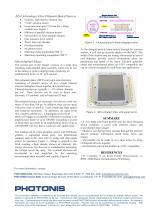
Catalog excerpts

CHARGED PARTICLE BEAM IMAGING SYSTEM B. Laprade, W. Netolicky, V. Grib, PHOTONIS USA, Sturbridge, MA 01566, and E. Schyns, Ph.D., PHOTONIS France SAS, Brive Cedex, France 19106 Abstract The high energy physics community has long sought a capability to determine location and focus of charged particle beams racing through accelerator tubes. Imaging a charged particle beam traveling at nearly the speed of light without changing the velocity or focus has proved to be a challenging task. emission array can be constructed from mosaic panels which are 80 X100 mm (each), typically 240 X 100 mm in the final configuration, Figure 1. One approach is used by astronomers to determine the location of black holes by observing the gravitational effects on nearby stars. A similar approach for imaging high velocity charged particle beams has proven successful. The PHOTONIS electron beam imager consists of a large electron generator array, a matching microchannel plate assembly and a readout. Voltage is applied to the EGA to create a high density shower of relatively low energy electrons. These electrons are accelerated to the matching MCP assembly and readout. As the charged particle beam travels through the “cold” electron shower, it will cast an electron shadow on the MCP. The width of the shadow and the timing information at arrival and departure provide critical information about the positioning and speed of the beam. These devices are UHV compatible and can be custom designed for each beam line. INTRODUCTION The precise determination of transverse beam profiles in accelerator and collider systems is critical to proper operation. One approach, known as an Ionization Profile Monitor (IPM), uses free electrons and ions produced as the bunches collide with light element residual gas molecules. The resultant ions and electrons can be laterally swept away and the resultant signals used to determine the beam profile [1]. Electron Generator Arrays • An Electron Generator Array is a specially processed microchannel structure which emits an Electron Beam from each channel when a voltage is applied across the array. The emission current can be modulated by simply changing the voltage across the array, Figure 2. Unlike filament-based devices, the EGA produces no heat. Electron Generator Arrays can be fabricated in various sizes and shapes with seamless active dimensions ranging from 3 to 150 mms. Very large arrays can be fabricated by tiling large rectangular arrays together. Emission Current (A) vs Applied Voltage (KV) Whenever scientists have had difficulty measuring small or fast events, they often find the answers lie in observing the things around the event of interest which can be observed. This approach is used by astrophysists to determine the location of black holes by observing the gravitational effects on nearby stars. A similar approach for imaging high velocity charged particle beams may also prove useful. APPROACH The PHOTONIS charged particle beam imager is a twopart system: The first part consists of a large area Electrogen™ Electron Generator Array (EGA). The Figure 2. The EGA emission current can be modulated by adjusting the array voltage. Data shown is for a 50 mm x 8 mm array.
Open the catalog to page 1
EGA Advantages Over Filament-Based Sources Uniform, high density electron flux “Cold” electron source Large emission area (150 mm dia.), tiling extends area, Figure 1 Millions of parallel electron beams Not sensitive to field strength changes Fine emission level control Won’t burn out, durable Excellent stability No photon noise Maximum bake temperature 300 °C Maximum operating temperature 200 ºC Microchannel Plates The second part of the imager consists of a large area matching microchannel plate assembly which can be run in the analog or pulse counting mode, producing an amplification...
Open the catalog to page 2All PHOTONIS catalogs and technical brochures
-
Neutronic [i]
2 Pages
-
Photonic Detector
4 Pages
-
Image Intensifier Tube ECHO
2 Pages
-
NOCTURN Cameras
4 Pages
-
Cricket
2 Pages
-
KAMELEON COLOR CMOS
2 Pages
-
Ion Beam Profiler
2 Pages
-
QUANTUM™ SUB-MINIATURE APD
1 Pages
-
NOCTURN GV Specifications
2 Pages
-
Low Light Imaging
4 Pages
-
Channeltron
4 Pages
-
Time of Flight MCP Detector
4 Pages
-
Micro Pore Optic
2 Pages
-
LongLife? MCP
4 Pages
-
NOCTURN U3 Specifications
2 Pages
-
NOCTURN MD Specifications
2 Pages
-
NOCTURN XL Specification
2 Pages
-
NOCTURN XS Specification
2 Pages
-
LYNX CMOS Sensor
2 Pages
-
NOCTURN Brochure
4 Pages
-
MANGUM 5900 series
2 Pages
-
Spiraltron Family
2 Pages
-
Miniature CEM
1 Pages
-
FOLG
2 Pages
-
Glass Capillary Array
2 Pages
-
FieldMaster
4 Pages
-
HPD
4 Pages
-
PF1054
1 Pages
-
PF1053
1 Pages
-
Onyx
2 Pages
-
XD-4 ?
2 Pages
-
XR5? brochure
2 Pages
-
Power Supplies
1 Pages
-
Electron Multipliers
4 Pages
-
Fiber Optic Light Guides
2 Pages
-
Microchannel Plates
4 Pages
-
Glass Coated Wire
1 Pages
-
Hybrid Photo Diodes
4 Pages
-
Optical Receiver
2 Pages
-
Streak Tube
16 Pages
-
TOF Selection Guide
4 Pages
-
APD Selection Guide
4 Pages
-
Image Intensifier Brochure
4 Pages


![Neutronic [i]](https://img.directindustry.com/pdf/repository_di/82199/neutronic-i-877797_1mg.jpg)














































